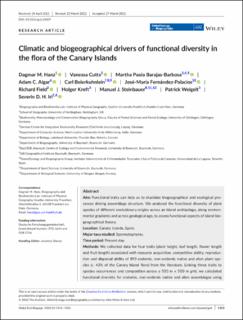| dc.contributor.author | Hanz, Dagmar M. | |
| dc.contributor.author | Cutts, Vanessa | |
| dc.contributor.author | Barajas-Barbosa, Martha Paola | |
| dc.contributor.author | Algar, Adam C. | |
| dc.contributor.author | Beierkuhnlein, Carl | |
| dc.contributor.author | Fernández-Palacios, José-María | |
| dc.contributor.author | Field, Richard | |
| dc.contributor.author | Kreft, Holger | |
| dc.contributor.author | Steinbauer, Manuel | |
| dc.contributor.author | Weigelt, Patrick | |
| dc.contributor.author | Irl, Severin D. H. | |
| dc.date.accessioned | 2023-02-27T09:08:54Z | |
| dc.date.available | 2023-02-27T09:08:54Z | |
| dc.date.created | 2022-04-24T13:16:30Z | |
| dc.date.issued | 2022 | |
| dc.identifier.issn | 1466-822X | |
| dc.identifier.uri | https://hdl.handle.net/11250/3054080 | |
| dc.description.abstract | Aim
Functional traits can help us to elucidate biogeographical and ecological processes driving assemblage structure. We analysed the functional diversity of plant species of different evolutionary origins across an island archipelago, along environmental gradients and across geological age, to assess functional aspects of island biogeographical theory.
Location
Canary Islands, Spain.
Major taxa studied
Spermatophytes.
Time period
Present day.
Methods
We collected data for four traits (plant height, leaf length, flower length and fruit length) associated with resource acquisition, competitive ability, reproduction and dispersal ability of 893 endemic, non-endemic native and alien plant species (c. 43% of the Canary Island flora) from the literature. Linking these traits to species occurrences and composition across a 500 m × 500 m grid, we calculated functional diversity for endemic, non-endemic native and alien assemblages using multidimensional functional hypervolumes and related the resulting patterns to climatic (humidity) and island biogeographical (geographical isolation, topographic complexity and geological age) gradients.
Results
Trait space of endemic and non-endemic native species overlapped considerably, and alien species added novel trait combinations, expanding the overall functional space of the Canary Islands. We found that functional diversity of endemic plant assemblages was highest in geographically isolated and humid grid cells. Functional diversity of non-endemic native assemblages was highest in less isolated and humid grid cells. In contrast, functional diversity of alien assemblages was highest in arid ecosystems. Topographic complexity and geological age had only a subordinate effect on functional diversity across floristic groups.
Main conclusions
We found that endemic and non-endemic native island species possess similar traits, whereas alien species tend to expand functional space in ecosystems where they have been introduced. The spatial distribution of the functional diversity of floristic groups is very distinct across environmental gradients, indicating that species assemblages of different evolutionary origins thrive functionally in dissimilar habitats. | en_US |
| dc.language.iso | eng | en_US |
| dc.publisher | Wiley | en_US |
| dc.rights | Navngivelse 4.0 Internasjonal | * |
| dc.rights.uri | http://creativecommons.org/licenses/by/4.0/deed.no | * |
| dc.title | Climatic and biogeographical drivers of functional diversity in the flora of the Canary Islands | en_US |
| dc.type | Journal article | en_US |
| dc.type | Peer reviewed | en_US |
| dc.description.version | publishedVersion | en_US |
| dc.rights.holder | Copyright 2022 The Authors. | en_US |
| cristin.ispublished | true | |
| cristin.fulltext | original | |
| cristin.qualitycode | 2 | |
| dc.identifier.doi | 10.1111/geb.13507 | |
| dc.identifier.cristin | 2018653 | |
| dc.source.journal | Global Ecology and Biogeography | en_US |
| dc.source.pagenumber | 1313-1331 | en_US |
| dc.identifier.citation | Global Ecology and Biogeography. 2022, 31 (7), 1313-1331. | en_US |
| dc.source.volume | 31 | en_US |
| dc.source.issue | 7 | en_US |

